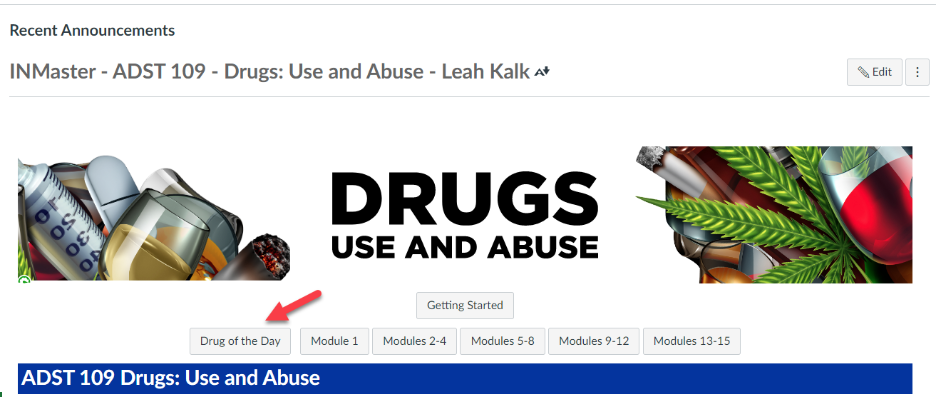Professor Leah Kalk’s online course, Addiction Studies (ADST) 109, centers around a weekly series of student-created Drug of the Day presentations. However, she had a student engagement problem with the assignment that she solved through improved course design. As Kalk herself said, “Previously they hated it, but this time they loved it.”

Problem: Not the content, but the structure
Kalk knew the essence of the Drug of the Day assignment was solid. A big part of Addiction Studies is getting valid information from reliable sources and then leading presentations and discussions about that information. The assignment involved all of that, and other students would learn about key drugs from presentations their peers created. What was going wrong?
Students never said the problem was the content itself; the problem was the way things were structured. To begin with, there would be at least one student (or as many as five) who didn’t complete the presentation and subsequently missed out on 15% of their course grade. Students indicated that it was hard to remember due dates, so sometimes they would complete the whole presentation on the day it was due or even the day after it was due. Part of the reason was because each presentation happened in a different week, so due dates were different for everyone. Plus, the presentation was due the week before the topic would be covered in class. Students would be confused about when their specific presentation was due or ask for an extension close to the deadline.
Furthermore, students expressed that it was hard to work as a group in an online environment. There were also students in groups who didn’t participate, which frustrated the other members.
Solution: Embrace the beauty of redundancy
Kalk reports that the Spring 2022 version of the class was the first time that all students completed the presentation and submitted it on time. Student evaluation comments revealed that they enjoyed the project, the choice of topic and time, learning from other students and that nobody was confused about due dates.
What changed? Central to the solution was the idea that if students struggle to find information, they might give up and then miss a deadline. It’s analogous to the shopping cart abandonment metric in ecommerce; evidence of this behavior could indicate some friction in your process.
“It was a mind-shift that redundancy in the course could be a positive thing. It helps students to find things easier and to retain key information.”
Leah Kalk
According to Kalk, “Through the course design process, I learned to put in reminders and accessible links in the different places that the students might look.” As you can see in the screenshots, a button on the course home page takes students to a module containing the essential materials (Image 1). In addition, there is a special module dedicated to Drug of the Day Presentation Information at the top of the modules section of the course (Image 2).


Moreover, there was a page in each module explaining what students had to do depending on their role that week (see the following example from a Canvas page in Module 6: 06.01b Drug of the Day Presentations). Rather than putting the assignment description and schedule information directly into a Canvas page, she put the information in Google Docs. Kalk explained, “Because everything was written in Google Docs instead of in Canvas itself, I could link to it instead of copying and pasting everything which would have been a nightmare if information changed.”
Conclusion
Kalk says that she had to remind herself that she’s been teaching for a long time so she understands where everything is stored, but students may not. “In my mind, it was very easy to find everything, so it was unnecessary to put links in different places.” The result is a more satisfying and accessible experience for Kalk and her students.
Resources
For help designing and teaching an online course, contact eCampus Center and request a consultation.
Article Credit
Thanks to professor Leah Kalk and Greg Snow, the eCampus instructional design consultant who worked with Kalk to design the ADST 109 course.